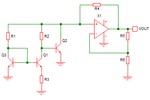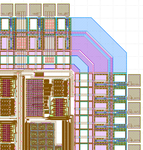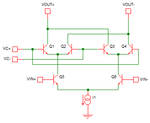By Chris Francis
(originally appeared on EEWorldonline)
I don't mean the transistor radio or mobile phone, but electronic devices and circuits that have been significant and enduring. Some are not necessarily "inventions", depending on how you define an invention, but significant designs, devices or techniques. It will depend on your area of interest (and age). You might think the GaAsFET was the most significant invention (or creation), or the thermionic triode. Anyway, here is my list of significant electronics inventions or designs. They are obviously influenced by my area of design. I am sure everyone will have a different list
1. Bandgap reference
I am always impressed by the concept of the bandgap reference. Take a reasonably accurate voltage reference but with a high-temperature coefficient and add in the appropriate proportion of something with the opposite temperature coefficient to get a voltage which is fairly accurate with temperature. They have been around since the 1960s are still in common use today. Thanks to Bob Widlar, Paul Brokaw and others.

2. MOSFETs & CMOS
As well as its use as a power device and RF uses, the MOSFET is the heart of most circuitry now — as CMOS. Before CMOS there was NMOS or PMOS (with higher power consumption) and before that bipolar. It is CMOS (and hence the MOSFET) that has allowed low power, high-density digital development, and makes possible the battery-operated portable products we now depend on.
3. Butterworth Filter
This might seem a strange one and I guess I should probably include other "classic" filter designs such as Bessel and Chebyshev. Maybe Butterworth filters aren't as popular now and have been superseded by digital filtering and more extreme filters for anti-aliasing. However, but I still fall back on the Butterworth as a good compromise when you don't want passband ripple but can tolerate the group delay. Also, you have to admire the skills of people like Stephen Butterworth who came up with the design in 1930 and published the design tables for making them from inductors and capacitors.
4. Integrated Circuit
Putting several transistors onto one piece of semiconductor material was a massive step forward in reducing size and allowing an increase in complexity. Now there can be several billion transistors on a chip. When you consider that computers were made from putting discrete transistors onto PCBs in order to make the basic logic building blocks, you can appreciate how much smaller things became even with fairly basic devices such as the 7000 series TTL logic ICs. Maybe 7000 series TTL deserves its own place in the top ten.

5. Bipolar Transistor
The humble bipolar transistor certainly deserves a mention. They followed on from vacuum tubes (valves) and are still in common use today, both as discrete devices and in integrated circuits. They are now mostly using silicon rather than germanium (and a few more exotic materials such as SiC and SiGe) but they helped the electronics boom we have today.
6. Microprocessor
The microprocessor first enabled desktop computers and now you can have so much computing power (and memory) in your hand it is mind-boggling compared to mainframe computers which might have had 32k of memory in the past. I remember seeing the Intersil 6100 microprocessor which would run the same instructions as the huge PDP-8 in the corner of a room at University. Now you effectively have a System-on-a-Chip with the microprocessor embedded within the main chip in your smartphone, but it all had to start somewhere (with the Intel 4004).
7. LED and LCD
Not really the same device but I am trying to keep the list short. The LED may seem trivial but without them, or another semiconductor alternative you would probably still be using incandescent bulbs as indicators. The LCD has enabled low power, high-resolution displays. Anyone remember Nixie tubes, gas discharge and incandescent filament displays? Devices are so much simpler and easier to design with LEDs and LCDs than they might otherwise have been.
8. Gilbert Cell
The Gilbert Cell and variants of it have been very useful building blocks for RF mixing/multiplication and continues to be so. I have used various IC versions and designed them into ICs as well. Again, still commonplace today, and thanks to Barrie Gilbert.

9. SPICE
Without SPICE (Simulation Program with Integrated Circuit Emphasis) or some other universal simulation tool we would be finding design a lot harder and more tedious, particularly IC design. It is not really an "electronic" invention or design, but a tool development, but one with a massive, long term impact.
10. Operational Amplifiers
A direct consequence of the ability to put a few dozen transistors on one chip, the opamp has become the popular, universal building block that is still commonplace today. There are thousands to choose from now with a huge range of performance characteristics: low noise; ultra-stable; wide bandwidth etc. They are also embedded within more complex ICs.
What does your list of the Top Ten Electronics Inventions look like? Let us know in the comment space below!
(originally appeared on EEWorldonline)
I don't mean the transistor radio or mobile phone, but electronic devices and circuits that have been significant and enduring. Some are not necessarily "inventions", depending on how you define an invention, but significant designs, devices or techniques. It will depend on your area of interest (and age). You might think the GaAsFET was the most significant invention (or creation), or the thermionic triode. Anyway, here is my list of significant electronics inventions or designs. They are obviously influenced by my area of design. I am sure everyone will have a different list
1. Bandgap reference
I am always impressed by the concept of the bandgap reference. Take a reasonably accurate voltage reference but with a high-temperature coefficient and add in the appropriate proportion of something with the opposite temperature coefficient to get a voltage which is fairly accurate with temperature. They have been around since the 1960s are still in common use today. Thanks to Bob Widlar, Paul Brokaw and others.
2. MOSFETs & CMOS
As well as its use as a power device and RF uses, the MOSFET is the heart of most circuitry now — as CMOS. Before CMOS there was NMOS or PMOS (with higher power consumption) and before that bipolar. It is CMOS (and hence the MOSFET) that has allowed low power, high-density digital development, and makes possible the battery-operated portable products we now depend on.
3. Butterworth Filter
This might seem a strange one and I guess I should probably include other "classic" filter designs such as Bessel and Chebyshev. Maybe Butterworth filters aren't as popular now and have been superseded by digital filtering and more extreme filters for anti-aliasing. However, but I still fall back on the Butterworth as a good compromise when you don't want passband ripple but can tolerate the group delay. Also, you have to admire the skills of people like Stephen Butterworth who came up with the design in 1930 and published the design tables for making them from inductors and capacitors.
4. Integrated Circuit
Putting several transistors onto one piece of semiconductor material was a massive step forward in reducing size and allowing an increase in complexity. Now there can be several billion transistors on a chip. When you consider that computers were made from putting discrete transistors onto PCBs in order to make the basic logic building blocks, you can appreciate how much smaller things became even with fairly basic devices such as the 7000 series TTL logic ICs. Maybe 7000 series TTL deserves its own place in the top ten.
5. Bipolar Transistor
The humble bipolar transistor certainly deserves a mention. They followed on from vacuum tubes (valves) and are still in common use today, both as discrete devices and in integrated circuits. They are now mostly using silicon rather than germanium (and a few more exotic materials such as SiC and SiGe) but they helped the electronics boom we have today.
6. Microprocessor
The microprocessor first enabled desktop computers and now you can have so much computing power (and memory) in your hand it is mind-boggling compared to mainframe computers which might have had 32k of memory in the past. I remember seeing the Intersil 6100 microprocessor which would run the same instructions as the huge PDP-8 in the corner of a room at University. Now you effectively have a System-on-a-Chip with the microprocessor embedded within the main chip in your smartphone, but it all had to start somewhere (with the Intel 4004).
7. LED and LCD
Not really the same device but I am trying to keep the list short. The LED may seem trivial but without them, or another semiconductor alternative you would probably still be using incandescent bulbs as indicators. The LCD has enabled low power, high-resolution displays. Anyone remember Nixie tubes, gas discharge and incandescent filament displays? Devices are so much simpler and easier to design with LEDs and LCDs than they might otherwise have been.
8. Gilbert Cell
The Gilbert Cell and variants of it have been very useful building blocks for RF mixing/multiplication and continues to be so. I have used various IC versions and designed them into ICs as well. Again, still commonplace today, and thanks to Barrie Gilbert.
9. SPICE
Without SPICE (Simulation Program with Integrated Circuit Emphasis) or some other universal simulation tool we would be finding design a lot harder and more tedious, particularly IC design. It is not really an "electronic" invention or design, but a tool development, but one with a massive, long term impact.
10. Operational Amplifiers
A direct consequence of the ability to put a few dozen transistors on one chip, the opamp has become the popular, universal building block that is still commonplace today. There are thousands to choose from now with a huge range of performance characteristics: low noise; ultra-stable; wide bandwidth etc. They are also embedded within more complex ICs.
What does your list of the Top Ten Electronics Inventions look like? Let us know in the comment space below!


